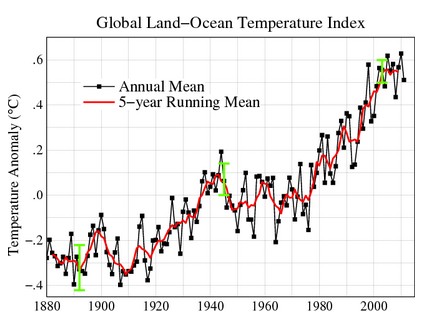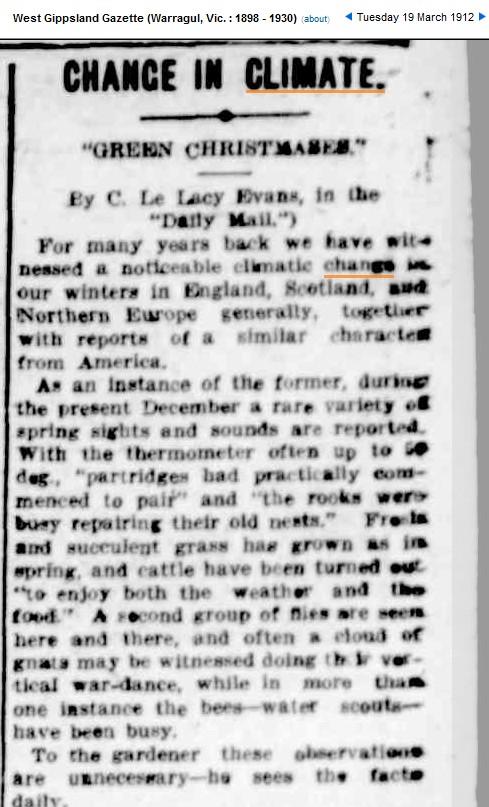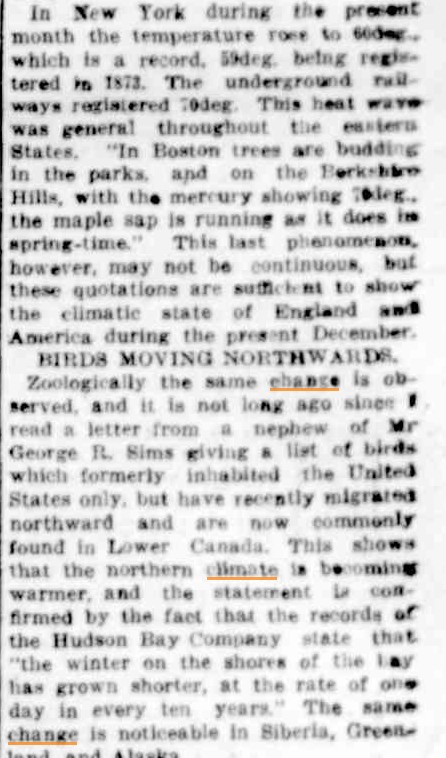I have found hundreds of news stories describing the melting of the Arctic between 1900 and 1940, as well as abundant evidence that Arctic ice expanded during the 1970s.
Unless the freezing point of water has changed, the earlier period must have been warmer. Yet when we look on Hansen’s graphs, it appears that the period from 1900 to 1940 was much colder than the 1970s.
Data.GISS: GISS Surface Temperature Analysis: Analysis Graphs and Plots
It doesn’t matter how beautiful your theory is, it doesn’t matter how smart you are. If it doesn’t agree with experiment, it’s wrong. Richard P. Feynman
Hansen shows 1912 as being one of the coldest years on record, but people who were living at the time saw a world which was completely different from Hansen’s fantasy graphs.






News stories aren’t science. (Perhaps you need to spin faster.)
Right. All those news stories about the Holocaust were probably made up.
“An unexpected cold wave in July 920 sent the people of Baghdad back under their blankets, forcing them to leave their summertime roof beds and go back inside, according to a new study by Spanish researchers. The temperature dropped about 16 degrees F compared to average July temperatures, the study found. That was in 920; there’s no “1” in there.
Arabic historians’ records chronicle life in Baghdad in the Middle Ages, and some of the reports mention the area’s climate. Now scientists have interpreted them for the first time, and found some surprising meteorological events in the areas now known as Iraq and Syria. It used to snow more often, with at least six snowfalls between 902 and 944. (There has been only one snowfall in Baghdad in modern times, on Jan. 11, 2008.) The Arabic historians also recounted droughts, floods, heavy rains and frost, not a common occurrence in the fertile crescent.
The researchers, led by Fernando Domínguez-Castro in the physics department at the University of Extremadura, believe a couple volcanic eruptions in central America could have been to blame for the July 920 cold snap. During some of those nights, temperatures never rose above 64 degrees F — pretty cool for a Baghdad July.”
http://www.popsci.com/science/article/2012-04/baghdad-used-get-more-snow-according-new-study-old-climate-records
Wrongway Appell strikes again! 😉
That’s typical of your typical method of false equivalences. Some news stories of some Arctic observations of 100 years ago hardly compare to the broad, constant measurements of the satellite era. You need to spend more time reading the science and less time looking up ancient newspaper articles — in this arena they don’t prove anything of a scientific capacity.
Arctic satellites from 1923 showed extensive melt.
A cold wave in Baghdad over 1000 years ago proves nothing about climate, of course. Using it here is pure propaganda.
David, the argument is:
1. Extensive news reporting on droughts and heatwaves during this time period.
2. Raw temp data consistent with (1)
3. Various demonstrations of very unusual adjustments to raw data.
There are multiple lines of evidence here. I.e., historical data + original measured data.
Good thing you aren’t a reporter, then, ’cause you are OLD news.
Does the news stories “are not science” only apply to past stories or does the present stories such as those in the NY Times or LA Times count?
Of course news stories in the NYT or LAT are not science. They are journalism or opinion.
You really don’t know the difference between a scientific journal and a newspaper??
With regards to CAGW is getting harder to tell the difference.
.
What’s happened to our education system when an ‘academic’ dismisses historical information as ‘opinion’ ? It’s a very sad state of affairs when ignorant statements are made by individuals who are meant to be part of our education ‘elite’.
“David Appell says:
July 29, 2012 at 11:45 pm
A cold wave in Baghdad over 1000 years ago proves nothing about climate, of course. Using it here is pure propaganda.”
Right over his head, as usual…
Here is yesterdays view of the cryosphere including Greenland: http://arctic.atmos.uiuc.edu/cryosphere/
Has The Freezing Point Of Water Changed?
David Appell says yes.
Steven,
Some time ago I made a comparison between GHCN stations dropped (died/disappeared) before 1992 and those that survived that year. You can compare regional results upto that year. Of course, you may take 1995 or another year, provided that you have enough stations for a comparison. My idea was a bit cynical, that data manipulation is less likely for dropped stations (let them rest in peace). I found big differences at high southern latitudes, especially the Antarctic. The differences were not only several degrees Celsius on average but also showed trends. Remember that during 1970-99 more than 9400 GHCN stations were dropped. Consider this as a tip to do survival analysis.
It should be noted that the blog post reaches an incorrect conclusion (that the 1970s were shown to be warmer in the Arctic than the warm period during the 1900-1940s timeframe on GISS), because it is using the wrong graph. The blog entry shows the global land and ocean anomalies. It does not show the Arctic anomalies from GISS. Those anomalies show the warm period in question. They also reveal that the current warmth exceeds the magnitude of that earlier warm period.
It should be noted that you have no idea what you are talking about. Arctic amplification is the most fundamental property of global warming theory. If the planet is warming, the Arctic is warming even more.
The planet is warming. The Arctic is warming more. Based on the GISS temperature record, the global land and ocean trend is +0.169°C per decade; the Northern Hemisphere trend is +0.255°C per decade; the Arctic region trend is +0.557°C per decade. A recent paper on the continuing warming can be found at: http://iopscience.iop.org/1748-9326/6/4/044022/pdf/1748-9326_6_4_044022.pdf
Brilliant logic. I falsify A, and then you say that I am wrong because I don’t agree with A.
The trend is based on the current 1981-2010 base period.
heh – the argument behind the Arctic “amplification” is based on the tropical “amplification” – which we don’t see.
There is no consistent theory of greenhouse warming. Pretty much, because it doesn’t exist.
You should also realize that GISS doesn’t even have a single thermometer above 80 degrees north. GISS data has been altered many times by Hansen. A 20 degree warming at a wet bulb of 0 is the equivalent of a warming of ONE DEGREE at a wet bulb of 80. That means that the tropics control the climate, and that warming or cooling of the arctic does not have the same energy exchange as the tropics. Don, you need to check the facts and get your head out of the sand.
Nah, he’s too busy looking at ostriches. THEY ARE ENDANGERED BECAUSE OF AGW.
Data adjustment is necessary if one is to have a reasonably accurate climate record. The paper describing the methodology and process for GISS can be found at: http://pubs.giss.nasa.gov/docs/2010/2010_Hansen_etal.pdf.
ROFLMAO!!!!!!
Giss has produced something they hope you believe is close to reality:
http://data.giss.nasa.gov/gistemp/abs_temp.html
Final points:
1. GISS is transparent. The data shows faster warming in the Arctic region than elsewhere.
2. The blog entry reaches an incorrect conclusion. It makes a statement concerning the Arctic, but then uses the wrong graph (global land and sea anomalies not Arctic anomalies) as supporting evidence.
GISS is very transperant:
Q. If SATs cannot be measured, how are SAT maps created ?
A. This can only be done with the help of computer models, the same models that are used to create the daily weather forecasts. We may start out the model with the few observed data that are available and fill in the rest with guesses (also called extrapolations) and then let the model run long enough so that the initial guesses no longer matter, but not too long in order to avoid that the inaccuracies of the model become relevant. This may be done starting from conditions from many years, so that the average (called a ‘climatology’) hopefully represents a typical map for the particular month or day of the year.
Transparent